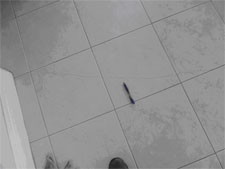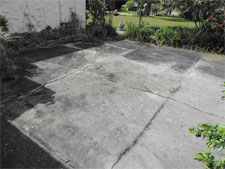Introduction
Most modern Florida homes are constructed with concrete slabs on compacted soil commonly known as a slab on grade. The concrete floor slabs are typically 4” thick with welded wire fabric for crack control. In many homes, which have ceramic, porcelain or natural stone floor tile installed over a concrete slab on grade, cracking of the floor tile is a concern. Typically, cracks in floor treatments caused by cracks in the slab below are relatively straight, cross grout lines and the tiles are bonded to the concrete floor slab pictured to the right.
Causes of Cracking of Concrete Slabs
Cracking of concrete slabs on grade is typically caused by restraint of movement brought about by shrinkage, thermal contraction and expansion. The outer portion of the slab restrains the middle portion of the slab. Structural members, such as, columns, footings, walls and other slabs, also restrain slabs. Cracks due to settlement may also occur.
These types of cracks are often the result of improper construction practices, such as:
- The lack of control joints and or joints too far apart or nonexistent.
- Isolation joints not provided around columns and walls.
- Concrete is of a low strength mix with too little cement, too much water, or both.
- Inadequate or lack of moist curing, especially in hot weather.
- Omission of control joints at re-entrant corners.
- Control joints not tooled to a depth of 1/4 of the slab thickness or greater.
- Inadequate slab thickness.
- Inadequate compaction and or preparation of the subgrade.
The Portland Concrete Association, Concrete Floors on Ground, which provides specifications and design guidelines for concrete slab on grade, recommends that control joints be provided every 10 to 15 feet. The actual spacing of the control joints is primarily a function of the layout of the room, slab thickness, size of aggregate in the mix, and the concrete slump.
Control joints (a.k.a. contraction joints) do not prevent the concrete slab from cracking; however, when properly spaced and constructed the slab will crack at the joint with minimal cracking at other locations. Control joints are not typically placed in residential interior floor slabs and for this reason this office has found many cases of shrinkage cracks in Florida homes.
Reinforcing steel or wire mesh, which is typically placed in concrete slabs on grade, does not prevent cracking but serves to control the crack widths by keeping the crack edges close together. Additionally, it is our experience that the wire mesh often ends up at the bottom of the slab instead of in the middle or upper middle where it can serve its purpose. Mesh in the bottom of the slab is useless for crack control.
Wider cracks are typically caused by settlement, both long and short term. Both short and long-term settlement occurs for a combination of reasons related to the preparation and compaction of the soil, which may include the presence of organic materials, the presence of debris, the natural raising and lowering of the ground water table or the compaction of soil from an accumulation of water runoff over the years.
Summary
In summary, it is concrete’s nature to crack and cracking cannot be totally prevented. However, with proper construction procedures, adequate jointing, and the use of quality materials cracking can be minimized and controlled.


